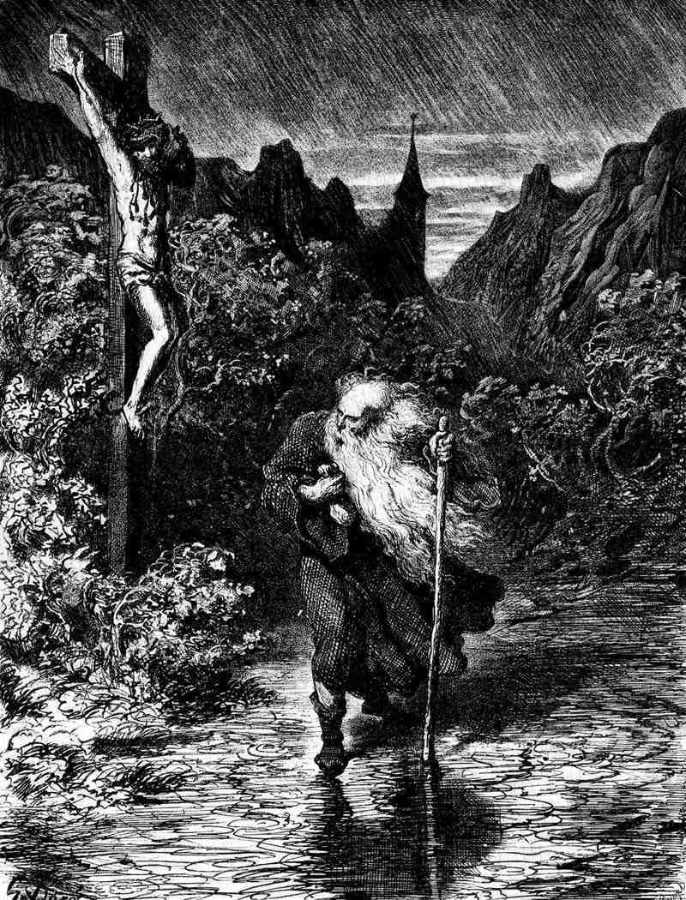The Wandering Jew is a mythical immortal man whose legend began to spread in Europe in the 13th century. In the original legend, a Jew who taunted Jesus on the way to the Crucifixion was then cursed to walk the Earth until the Second Coming. The exact nature of the wanderer’s indiscretion varies in different versions of the tale, as do aspects of his character; sometimes he is said to be a shoemaker or other tradesman, while sometimes he is the doorman at the estate of Pontius Pilate. An early extant manuscript containing the Legend is the Flores Historiarum by Roger of Wendover, where it appears in the part for the year 1228, under the title Of the Jew Joseph who is still alive awaiting the last coming of Christ. The central figure is named Cartaphilus before being baptized later by Ananias as Joseph. The root of the name Cartaphilus can be divided into kartos and philos, which can be translated roughly as “dearly” and “loved”, connecting the Legend of the Wandering Jew to “the disciple whom Jesus loved”. The origins of the legend are uncertain; perhaps one element is the story in Genesis of Cain, who is issued with a similar punishment—to wander the Earth, scavenging and never reaping, although without the related punishment of endlessness. By the beginning of the eighteenth century, the figure of the “Wandering Jew” as a legendary individual had begun to be identified with the fate of the Jewish people as a whole. After the ascendancy of Napoleon Bonaparte at the end of the century and the emancipating reforms in European countries connected with the policy of Napoleon and the Jews, the “Eternal Jew” became an increasingly “symbolic … and universal character” as the continuing struggle for Jewish emancipation in Prussia and elsewhere in Europe in the course of the nineteenth century gave rise to what came to be referred to as “the Jewish Question”.
| Alias Wandering Jew, Eternal Jew (Ewiger Jude), Shoemaker of Jerusalem |
| Real Names/Alt Names Cartaphilus, Joseph, Ahasver, Ahasuerus, Matathias, Buttadeus, Isaac Laquedem |
| Characteristics Personification, Biblical Figures, Myths & Legends, Occult, Immortal, Classical Antiquity |
| Creators/Key Contributors ○ |
| First Appearance Chronica Majora (c.1228) |
| First Publisher ○ |
| Appearance List Literature: Chronica Majora (c.1228) by Matthew Paris, Kurtze Beschreibung und Erzehlung von einem Juden mit Namen Ahasverus (1602) by Anonymous, The Wandering Jew Telling Fortunes to Englishmen (1625) by Anonymous, Le Juif errant (1820) by Pierre-Jean de Béranger, Le Juif errant (1844–1845) by Eugène Sue, The Wandering Jew (1866) by George Croly, The Wandering Jew (1873) by S. Baring-Gould, The Wandering Jew (1893) by Edwin Booth and Lawrence Barrett, Der Ewige Jude (1902) by Joseph Haltrich, The Wandering Jew Has Arrived (1948) by Stefan Heym, The Wandering Jew (1969) by Sholem Asch. |
| Sample Read The Wandering Jew — Complete by Eugène Sue [PG] |
| Description The Wandering Jew is a mythical immortal man whose legend began to spread in Europe in the 13th century. In the original legend, a Jew who taunted Jesus on the way to the Crucifixion was then cursed to walk the Earth until the Second Coming. The exact nature of the wanderer’s indiscretion varies in different versions of the tale, as do aspects of his character; sometimes he is said to be a shoemaker or other tradesman, while sometimes he is the doorman at the estate of Pontius Pilate. An early extant manuscript containing the Legend is the Flores Historiarum by Roger of Wendover, where it appears in the part for the year 1228, under the title Of the Jew Joseph who is still alive awaiting the last coming of Christ. The central figure is named Cartaphilus before being baptized later by Ananias as Joseph. The root of the name Cartaphilus can be divided into kartos and philos, which can be translated roughly as “dearly” and “loved”, connecting the Legend of the Wandering Jew to “the disciple whom Jesus loved”. The origins of the legend are uncertain; perhaps one element is the story in Genesis of Cain, who is issued with a similar punishment—to wander the Earth, scavenging and never reaping, although without the related punishment of endlessness. By the beginning of the eighteenth century, the figure of the “Wandering Jew” as a legendary individual had begun to be identified with the fate of the Jewish people as a whole. After the ascendancy of Napoleon Bonaparte at the end of the century and the emancipating reforms in European countries connected with the policy of Napoleon and the Jews, the “Eternal Jew” became an increasingly “symbolic … and universal character” as the continuing struggle for Jewish emancipation in Prussia and elsewhere in Europe in the course of the nineteenth century gave rise to what came to be referred to as “the Jewish Question”. |
| Source Wandering Jew – Wikipedia |


